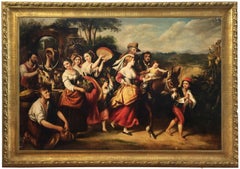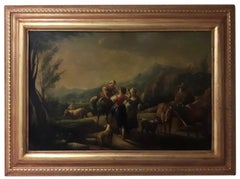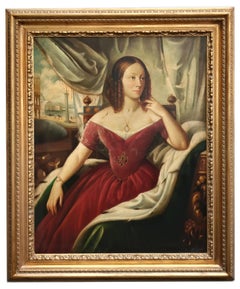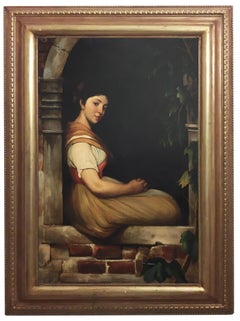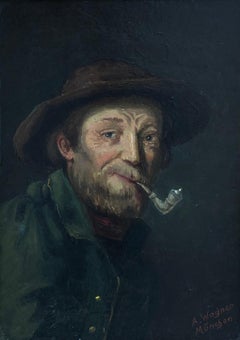Giovanni Santaniello Art
to
1
3
1
Overall Width
to
Overall Height
to
5
1
3
2
5
3
3
3
1
1
1
5
5
5
5
5
9,345
2,690
1,367
1,354
3
5
5
Artist: Giovanni Santaniello
COUNTRY SCENE- Italian School - Figurative Italian Oil on Canvas Painting
By Giovanni Santaniello
Located in Napoli, IT
Country scene - Oil on canvas cm.80x120, Giovanni Santaniello, Italy 2002
Gold gilded wooden frame available on request
The painting by Giovanni Santaniello depicts a scene of return...
Category
Early 2000s Old Masters Giovanni Santaniello Art
Materials
Canvas, Oil
LADY READING - French School - Figurative Italian Oil on canvas painting
By Giovanni Santaniello
Located in Napoli, IT
Lady Reading - Figurative oil on canvas painting cm.80x60, Giovanni Santaniell, Italy 2002
In this painting, Giovanni Santaniello drew inspiration from t...
Category
Early 2000s French School Giovanni Santaniello Art
Materials
Canvas, Oil
COUNTRY SCENE - Italian School - Italy - Oil on canvas painting
By Giovanni Santaniello
Located in Napoli, IT
Country scene - Giovanni Santaniello Italia 2002 - Oil on canvas cm. 60x90.
Giovanni Santaniello's painting depicts a landscape with peasant women and herds, the painting is inspired...
Category
Early 2000s Dutch School Giovanni Santaniello Art
Materials
Canvas, Oil
LADY'S PORTRAIT - Venetian School - Oil on Canvas Italian Figurative Painting
By Giovanni Santaniello
Located in Napoli, IT
Lady's portrait - Giovanni Santaniello Italia 2002 - Oil on canvas cm. 100 x 80
The painting by Giovanni Santaniello depicts a portrait of a beautiful pensive woman in elegant clothe...
Category
Early 2000s Italian School Giovanni Santaniello Art
Materials
Canvas, Oil
CHILD- In the Manner of W.A. Bouguereau Figurative Italian Oil on Canvas Paint
By Giovanni Santaniello
Located in Napoli, IT
Child - Oil on canvas cm.90x60, Giovanni Santaniello, Italy 2002
The painting by Giovanni Santaniello depicts a young girl sitting under a stone arch, the painting is inspired by th...
Category
Early 2000s French School Giovanni Santaniello Art
Materials
Canvas, Oil
Related Items
Fine 18th Century British Portrait of an Aristocratic Lady, Large oil painting
Located in Cirencester, Gloucestershire
Circle of Thomas Hudson (1701-1779) British.
18th Century Bust Portrait of a Lady,
Oil on Canvas, Inscribed on a label verso,
canvas: 30" x 25" (76.2 x 63.5cm).
frame: 30 x 25 in...
Category
Mid-18th Century Old Masters Giovanni Santaniello Art
Materials
Canvas, Oil
$3,415
H 35 in W 30 in D 1 in
Bearded man with pipe and hat
Located in Genève, GE
Work on wood
Carved wooden frame
41 x 36.5 x 7 cm
Category
Early 20th Century Dutch School Giovanni Santaniello Art
Materials
Oil
Feeding the Baby
Located in Wiscasett, ME
Oil on canvas, signed upper left. Provenance: Sothebys Amsterdam, Private collection London, Private collection Palm Beach.
His working period was from about 1894 to 1973, successively in Rotterdam, Heeze (Heeze-Leende), Hilversum and Laren. He was educated at the Craft School for decorative painters and received evening lessons at the Rotterdam Academy under the direction of A. van Maasdijk.
He was a member of the Vereeniging Sint Lucas...
Category
Early 20th Century Dutch School Giovanni Santaniello Art
Materials
Oil
17th Century Italian Old Master Oil Painting Moses Striking Water from the Rock
By Pier (Pietro) Dandini
Located in Cirencester, Gloucestershire
Moses Striking Water from the Rock;
Circle of Pietro Dandini, Italian 1646-1712
Italian School, late 17th century
oil on canvas, framed
framed: 3...
Category
Early 18th Century Old Masters Giovanni Santaniello Art
Materials
Canvas, Oil
$8,556
H 32 in W 28 in D 1 in
A Mother and Her Children
By Bernard Pothast
Located in Wiscasett, ME
This is an original unique oil painting by the artist Bernard Pothast, signed in the lower right corner, featuring a mother and her children sitting around the kitchen table. Measu...
Category
Early 20th Century Dutch School Giovanni Santaniello Art
Materials
Oil
Italian 18th Century Oval Religious Oil on Canvas Painting with Saint Dominic
By Francesco de Mura
Located in Firenze, IT
This beautiful Italian 18th Century old masters oil painting on oval canvas with giltwood frame is attributed to Solimena and features a religious scene.
In this splendid oval-shaped painting are depicted Saint Dominic...
Category
18th Century Old Masters Giovanni Santaniello Art
Materials
Canvas, Oil
$13,040
H 21.66 in Dm 15.75 in
Perseus and Andromeda
Located in Paris, Île-de-France
Carle Vanloo (Nice 1705 – Paris 1765)
Perseus and Andromeda
Oil on canvas. H. 081; W. 065.
Alongside François Boucher (1703-1770) and Charles-Joseph Natoire (1700-1777), Carle Vanlo...
Category
1720s Old Masters Giovanni Santaniello Art
Materials
Oil, Canvas
1600's Flemish Old Master Oil Painting The Virgin & Child Mastertpiece Work
Located in Cirencester, Gloucestershire
The Virgin & Child
Flemish School, circa 1600
circle of Cornelis van Cleve (Flemish c. 1520-1614),
oil painting on canvas
canvas: 37 x 30 inches
provenance: private collection, Paris...
Category
Early 17th Century Old Masters Giovanni Santaniello Art
Materials
Canvas, Oil
$8,981 Sale Price
54% Off
H 44 in W 36 in D 1 in
Large 18th Century British Old Master Oil Painting Figures at Dusk in Woodland
Located in Cirencester, Gloucestershire
The Close of Day
English artist, second half 18th century
circle of Thomas Gainsborough (British 1727-1788)
oil on canvas, unframed
canvas: 24.5 x 29 inches
provenance: private colle...
Category
18th Century Old Masters Giovanni Santaniello Art
Materials
Oil, Canvas
$2,409 Sale Price
20% Off
H 24.5 in W 29 in
Landscape Near Felday, Surrey
By Abraham Hulk the Younger
Located in Hillsborough, NC
Dutch/English artist Abraham Hulk the Younger (1851-1922) is most known for landscapes of the British countryside. This work is one of a pair (the second work is also available by s...
Category
Late 19th Century Old Masters Giovanni Santaniello Art
Materials
Canvas, Oil
$2,240 Sale Price
20% Off
H 27 in W 22.75 in D 2.13 in
Mid 19th Century French Provincial Oil Portrait of Lady & Her Dog, framed
Located in Cirencester, Gloucestershire
Portrait of a Lady with her Pet Dog
French School, mid 19th century
oil on canvas, framed
framed: 36 x 28 inches
canvas: 29 x 20 inches
Provenance: private collection, France
Conditi...
Category
Mid-19th Century French School Giovanni Santaniello Art
Materials
Oil, Canvas
$1,737 Sale Price
20% Off
H 36 in W 28 in
17th Century French Old Master Oil Painting Classical Robed Semi Nude Figures
Located in Cirencester, Gloucestershire
17th century French School
circle of Nicolas Poussin (French 1594-1665)
"Figures in Arcadia"
oil on canvas, unframed
canvas: 16 x 20 inches
provenance: private collection, England
condition: very good and sound condition
Nicolas Poussin was a renowned French painter of the 17th century. He is considered one of the greatest figures of classical French Baroque art...
Category
17th Century Old Masters Giovanni Santaniello Art
Materials
Oil, Canvas
$5,992 Sale Price
20% Off
H 16 in W 20 in
Giovanni Santaniello art for sale on 1stDibs.
Find a wide variety of authentic Giovanni Santaniello art available for sale on 1stDibs. You can also browse by medium to find art by Giovanni Santaniello in canvas, fabric, oil paint and more. Much of the original work by this artist or collective was created during the 21st century and contemporary and is mostly associated with the Old Masters style. Not every interior allows for large Giovanni Santaniello art, so small editions measuring 24 inches across are available. Customers who are interested in this artist might also find the work of Emilio Pergola, Charles Zacharie Landelle, and Achille-Émile Othon Friesz. Giovanni Santaniello art prices can differ depending upon medium, time period and other attributes. On 1stDibs, the price for these items starts at $3,459 and tops out at $6,369, while the average work can sell for $3,689.
